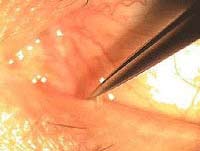Punctal Occlusion For Dry Eyes
INTRODUCTION

HOW IT WORKS
One way to alleviate dry eye is to help the eyes to make longer use of whatever amount of naturally lubricating tears they do produce or that are added artificially (eye drops). This is best accomplished by closing off the small funnel-like drain hole found in the inner corner of the upper and lower eyelids.

This drain hole, called a punctum, may be closed with a tiny plug called a punctal plug or permanently closed with a cauterizing heat or electrical procedure. The punctum are typically closed in only the lower ducts of both eyes, and only occasionally in all four ducts, top and bottom.

TYPES
Punctal plugs can be temporary or semi-permanent. Temporary plugs dissolve a few days after insertion. They are typically used to determine the effectiveness of plugging the punctum. If the temporary plugs provided the needed relief from dry eye, then semi-permanent plugs made of silicone can be used as replacements. The semi-permanent plugs are non-dissolving and may be removed in the future if desired or necessary, such as in the case of some patients who may find the semi-permanent plugs to be irritating due to the edge of their cap rubbing against the eye. For this reason patients may prefer long-acting dissolvable plugs that are inserted into the puncture without a cap protruding. These plugs can be placed in Dr. Seibel’s office with eyedrops anesthesia.

Punctal occlusion by electrocautery is a permanent (irreversible) alternative to plugs. Should your dry eye symptoms disappear after the temporary plugs are inserted, you and Dr. Seibel may want to consider permanent punctal occlusion. If permanent punctal occlusion is considered desirable, the methods most widely used and most effective in producing permanent closure are:
- Electrodesiccation – closing off with electricity
- Thermal cautery – closing off with heat
Very occasionally, permanent occlusion may need to be repeated in order to be fully effective.
SURGICAL PROCEDURE
Plug insertion is performed in an examination room; it does not require a surgery center. Once you have been checked in and settled comfortably, drops will be used to numb your eye; no injections are needed.

The procedure is basically the same for permanent occlusion, only a device is used to seal off (cauterize) the opening and nothing is inserted.
RECOVERY
Many patients report immediate relief from dry eye symptoms and resume normal activities immediately. Serious complications with punctal occlusion are extremely rare, but like any medical procedure, it does have some risks. If you experience any discomfort with the semi-permanent plugs, Dr. Seibel can easily remove them.